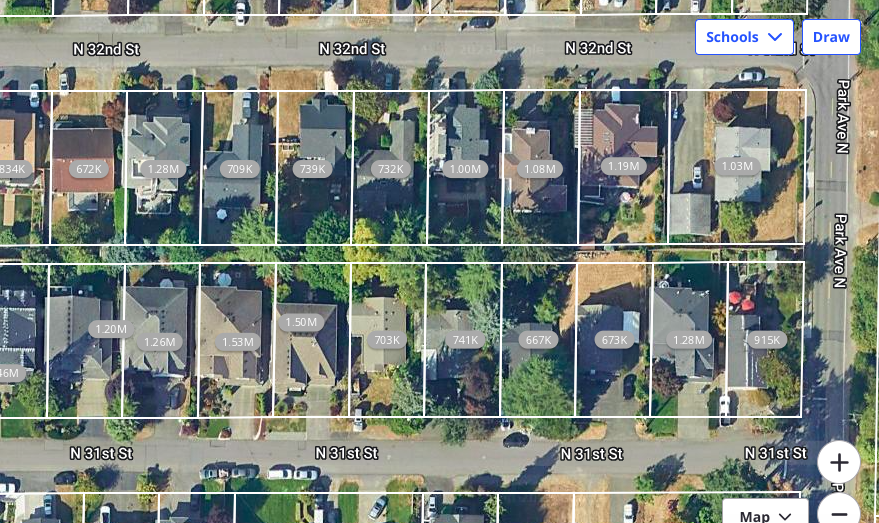
This image capture from Zillow shows an unused right-of-way running between the homes on N 31st and N 32nds streets. As can be seen from the mature trees and fence lines, this right of way has not been opened as an alley.
In 1904 Renton’s Lower Kennydale neighborhood was platted in what-was-then King County. The “Garden of Eden” plat included a grid street pattern, along with some additional right-of-ways that could be developed into alleys to potentially allow the residents to get their horses and carriages behind their homes. Some of these right-of-ways were eventually formally abandoned by Renton, and others have remained on-the-books but undeveloped and unopened for the past 100 years. The unopened “alleys” now host large native trees and gardens, and in some cases sheds and other backyard uses.
Starting about eight years ago, Renton’s building codes began to dictate that new homes that are built on alleys should take garage access from that alley. (This code was intended to affect only new construction, not existing homes.) A developer is now proposing a new house on one of these lots with an unopened right-of-way behind it, that runs from Park Avenue to Burnett between homes on N 31st Street and N 32nd Street. In a preliminary review the city has said the developer should get access from the (unopened) “alley”, and the preliminary decision has left neighboring residents upset and crying foul.
Kennydale residents turned up in large numbers at last Monday’s council meeting, describing in detail why they are concerned about an alley being built through their neighborhood after all these decades. The development pattern has been set for 100 years, and an alley is now more disruptive than it is helpful for residents of most or all of the historic homes. Among the worrisome issues identified, residents are concerned about saving 100-year old trees, preserving camaraderie with long-time over-the-fence neighbors, preserving their yards and gardens, and needlessly creating new security concerns behind their homes.
Residents have petitioned the city to abandon the right-of-way under the official “vacation” process identified in city and state laws, instead of developing it into an alley. I think they make a strong case. While I am not a lawyer and I am offering a political–not legal–opinion, this right-of-way appears to never have been formally opened (i.e. turned into an actual alley). If it had not been part of a plat, and simply deeded to the County as a stand-alone right of way, it likely would have expired after five years of not being opened under RCW 36.87.090. ( If it had been platted a few years earlier before 1904, when RCW 36.87.090 went into effect, it also could have expired by now even if it is part of a plat.) There should be deference given to the street pattern established at the time an area is developed, and changing it after 100 years is not a step that should be taken lightly.
The process for vacating a right of way can be expensive and complicated for residents, and the Renton City Council will ultimately have decision-making authority on whether this right-of-way is vacated and how much compensation is charged for the land. (The price set for vacated land could be anywhere from zero to 100% of current appraised value, depending on how the land was originally acquired by the government and other factors.) I encourage Council Members to look carefully at the facts and long history in this case, and make this process as easy and fair as possible for the residents.
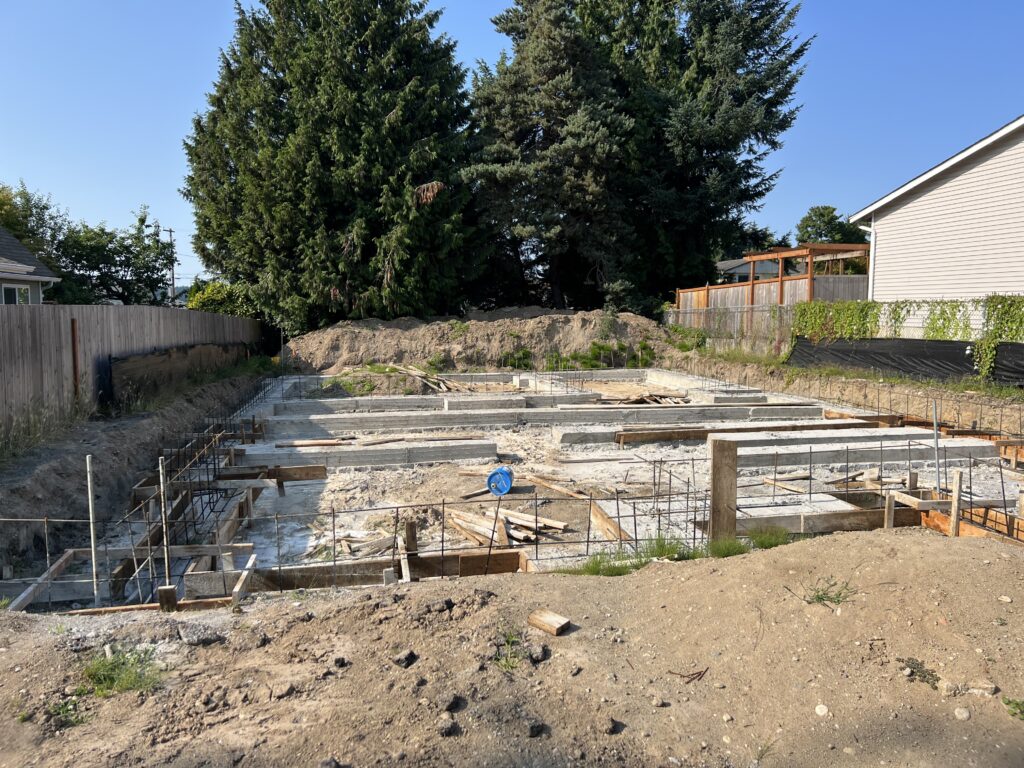
A foundation footing has been poured for a new home on N 31st street, and the footing is oriented with the garage at the back. The 5 foot side yard setbacks are not wide enough for cars to get to the back, and there is currently no developed alley at the back.
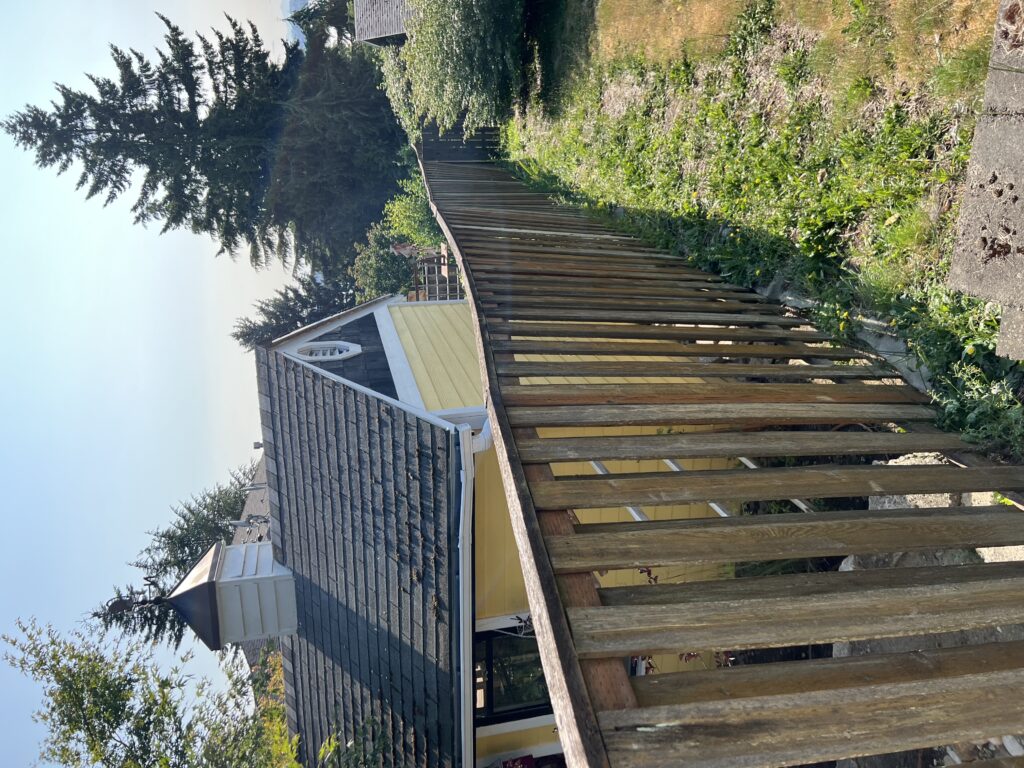
The view of the century-old right-of-way from the sidewalk on Park Avenue. The 12-foot-wide right-of-way is approximately centered on this fence-line, then runs through the large tree in the background, and continues for hundreds of feet (through more fences and retaining walls) to Burnett Ave North. The grade drops off steeply from right to left, and from front to back.
Related topic: It’s common for surrounding residents to use unopened/unused right-of-ways for incidental purposes in conjunction with their homesteads (such as gardening, recreating, or storage.) The University of Washington Law review published an article about this tendency, and the legal precedents surrounding it.

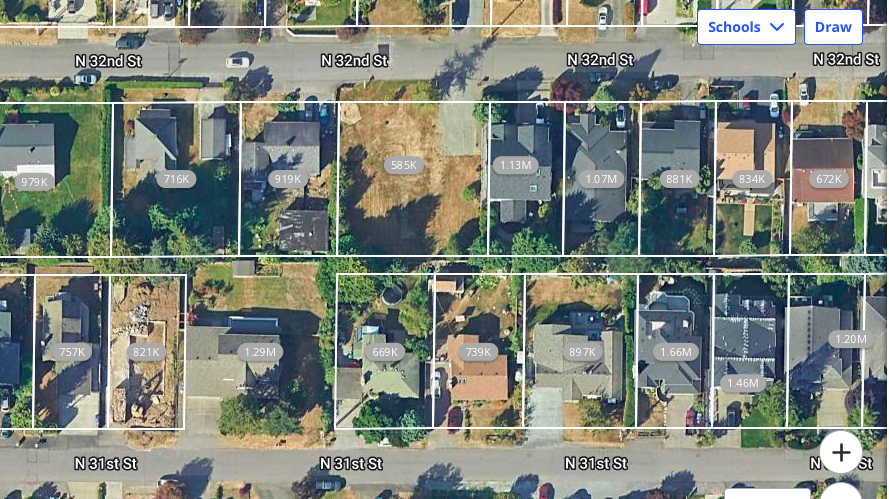
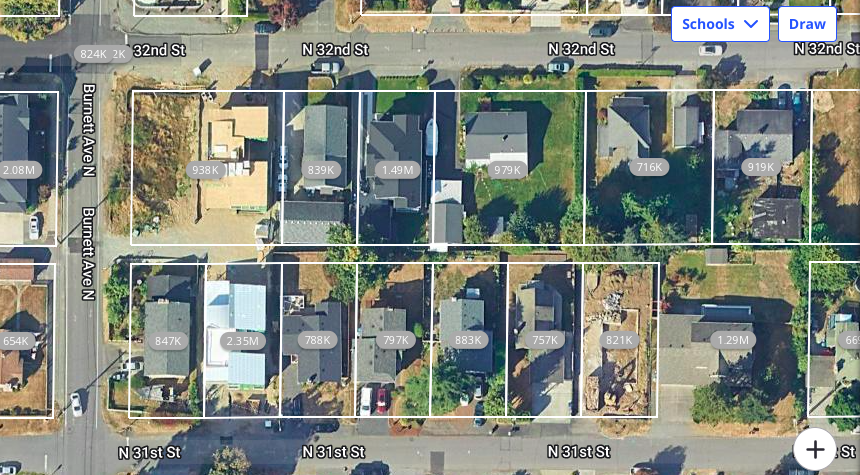

Residents should be careful what they wish for. If there’s no alley, then a developer could buy up a block of homes and plop down very high density apartments based on the new RCW.
It’s a good point to always think about the future in which fourplexes are allowed throughout Renton neighborhoods due to the recent State Legislature action known as HB 1110 (described here. https://www.randycorman.com/?p=13465.) I’m not sure the future is better for existing Kennydale homeowners with a developed alley between the blocks. HB 1110 prevents cities from zoning fourplexes out of neighborhoods, but it allows current setbacks and lot line coverage regulations to stay in place. Kennydale residents have been coping for years with builders tearing down historic houses and then covering every inch of available property, from setback to setback, with new single-family houses.
They might see the market switch to fourplex with HB 1110, except that developers may not be that interested in building fourplexes in a suburban location that does not have enough parking to support it. (HB 1110 says cities can’t use parking regulations to prevent fourplex development, but it does not put a burden on cities to satisfy market-need for parking). A new alley might provide plenty of new parking opportunities, and promote the market switch to fourplexes. Residents who have no interest in redevelopment, and just want to be able to enjoy their single-family home even if fourplexes get built in the neighborhood, will have a harder time doing so of the fourplexes are served by an alley running through their backyards.
These are just my thoughts on the topic. I would like to hear from others. I also recommend neighborhoods get together, create plans for what they want, and be outspoken about what they need from their city leaders during this time of state-mandated zoning change and uncertainty. Kennydale is setting a good example of that. Meanwhile Renton Council Members need to think carefully through how to meet state legal requirements and build more housing per state mandates without ruining quality of life for current residents. It’s going to be hard work and require a great deal of careful planning.
What kind of restrictions/requirements are necessary for parking when upzoning like fourplexes where they weren’t allowed before? Or maybe apartments that restrict the parking so people are forced to park on the City Streets?
Sounds like 100 years of adverse possession of their own property. Case closed..
I don’t think this is what the alley code was intended to do. If the whole block was going to be redeveloped, then the code would apply. I oppose cutting down the trees that are mature to let this alley be put in. This would have adverse affects on a number of residents making them remove fences and sheds that have been in place for many years.
The city should let every block decide by voting. I forget the name, but a group of homes can elect to pay for a benefit by adding property tax.
Right, you are remembering a Local Improvement District, known as a LID for short. With a LID, a majority of neighbors can vote to collectively pay for and build sidewalks, pave an alley, or make other improvements as a neighborhood. The city helps coordinate the work, and places an assessment on each property. (These are not very common, as many people are maxed out with their budgets and not likely to support a LID.)
In this Kennydale case the neighbors have done a different type of voting, with a majority agreeing to petition for the city to abandon (vacate) the alley right-of-way. They had to pay over $500 to file the petition, and they’ll need to pay $2000-$3000 for an appraisal of the property. Then they would have to pay some other fees, and finally they would have to collectively pay whatever price the Council decided they should charge for the property.
Meanwhile, a homebuilder has poured a foundation with the garage in the back, apparently expecting to use a new alley for access to the house he’s building. While I’ve not made a detailed estimate, I’ve gone out to the site, and I’m guessing that it would cost many hundreds of thousands of dollars, maybe in the millions, to develop the alley he needs. Developing the alley would require resolving legal and political issues with the adjacent property owners, followed by permitting, then grading, retaining walls, drainage, road bed construction, and paving over hundreds of feet. No one is going to want to pay for this.
I feel for the homebuilder, but his architect was the one to let him down by not walking the property and not noticing the lack of an alleyway. FYI, the city is not at fault for demanding the unobtainable. Many court cases say that it’s the property owner’s responsibility to make sure the plans are sane.
If the new illegally poured foundation (no permit) truly has 5’ setbacks on both sides, that is another violation. Code calls for minimum5’ setback but must total 15’ toal for both sides.
Sorry, I was writing this with grandson in tow.
Minimum 5’ setback each side but must total 15’ for both sides.
Thanks Paul for the important reminder that side yard setback requirements often specify more than 10 feet total. I’m sure setback requirements are a topic of great interest to many in Kennydale and other Renton neighborhoods with the amount of new construction occurring, and these setbacks do vary depending on zone. Your comment reminded me that many Kennydale properties are in R6 zoning, which does require a combined total of at least 15 feet of side yard setback with 5 foot minimum per side.
So I checked the zoning map, and it looks like the property with the new foundation that started this is about five or six houses into the R8 zone (on the west side of Park Ave). I think this means a five-foot setback on each side would be sufficient in this part of the Kennydale neighborhood, although it would not suffice in all of Kennydale. (Note that I am not the building official and not a lawyer, so this is only my informal opinion)
Others may be interested in the various setback requirements in Kennydale, so I’ve included links to the zoning map and to the setback table below. Sometimes zoning overlays or special conditions can apply, or internet maps can be out-of-date, so it’s always important for builders to check with the city building department for specific setback requirements before they begin design work on new additions or new buildings.
Zoning Map:
https://gismaps.rentonwa.gov/GISIMAGES/STATICMAPS/Zoning.pdf
Setback table: https://www.codepublishing.com/WA/Renton/html/Renton04/Renton0402/Renton0402110A.html
Seems right to give the property to the homeowners after so many years. Cheapest option for everyone concerned is probably to alter the foundation footing as needed and don’t waste more time on this.
Similar platted alleys have been removed by adjacent streets over the years without issue. City gets more revenue and a liability off the books, homeowners don’t have to deal with a street in their literal back yard. Win win.
If it goes that route, the homeowners should check the original plat map as I’ve seen about 20% of the last only granted the city an easement and not necessarily ownership for the alley. Some of the plats show that even for the street out front.
The whole issue of these platted alleys should have been addressed as a bundle years ago.
Developers are using their influence to utilize all the rules associated with new property configurations based on alley right of ways . This includes closer street facing setbacks to create mega structures never imagined on lots 5100 sq ft . The ability to clear old growth trees without constraints to open views for one and loss of nature for many.
The net effect is lots of enclosed people space and no room for green space in the yard to relax and do all the things people in suburbia enjoy: a patch of grass, flowerbeds and an enclosed space for kids to play .
Good point!
The developer causing all this chaos in Kennydale, runs the Cloud Break coffee shop in the same neighborhood. He pretends to be the nice coffee shop owner, at the same time that he is cutting open peoples backyards for his own financial gain .
Hi, I live next to this construction site. When they built the foundation, the worker damaged my fences on 1st April 2023. I called the builder – Kevin and explained what had happened. He said he would fix it and he said he is just building a small house, not a big house. But obviously, he is building a BIG house as the new foundation is not following proper setbacks. And there wasn’t any notification board that notify me about the alley, nor he mentioned anything about the alleyway being on the phone. The fact that he lied about the size of the new house, and he still has not fixed my fence shows that he is a very unreliable and irresponsible builder. I am highly concerned he is underestimating the amount of work in building a proper Alley and leaving the neighborhood at risk, damaging the environment we all love and live in.
Randy, I appreciate you bringing this issue to light, but given your candidacy for city council, I would caution you not to appear overly focused on Lower Kennydale regulatory and land use issues, as doing so gives the impression that you’re beholden to the wealthy elite of Renton. You’ve advocated vociferously for Lower Kennydale movers and shakers’ concerns before, such as with the proposed new dock regulations. I’m sure you’ve done so in good faith, but I personally get really annoyed when the rich and powerful are able to push their issues to the front of the line, simply because they have the ear of the right people… and are willing to fundraisers for them. While I do think this alley situation is important to the affected homeowners, we have a lot more critical problems to address in the city that could fill the pages of your blog. Hopefully you’ll find a way to retain the support of these donors without being so, um, obvious about highlighting their issues, and thank you for considering my advice.
Dear SouthLakeWa. My wife and I bought our little 2 bedroom affordable house 20 years ago here on 31st St. We are retired on a fixed income, not wealthy elitists. The big push to open this alley right of way only enables developers to add greater density to our neighborhood while constructing $2M to $3M homes all in the name of ‘affordable housing’. Those of us with truly affordable homes are being forced out by developers who care about maximum capitation. Truth be told, if the alley were abandoned, the resultant set-back would allow us to utilize the City’s PR-ADU program and build an ADU for our dad.
Mark describes it the way I see it. Working and retired people with homes in Kennydale, many of them purchased decades ago, getting squeezed out by high taxes and development forces; development forces that could be better managed to encourage new housing and growth while minimizing impacts on existing homes. There is nothing fair or right about needlessly harming people’s property, or changing it so much after 120 years that they can’t enjoy it they way they are used to. I’ve shown the same concern and care through all of Renton over the years, not just Kennydale.
This new multi-million dollar house does not need to load from an alley, when the surrounding modest ramblers and craftsmen homes do fine loading from the street. I don’t object to new expensive homes being built, but they should be constructed in a way that preserves the livability of our older housing stock when possible, as the older housing stock is our more affordable housing.
Note that by simply not requiring this home to load from the (unopened) alley, it preserves the backyards of the older homes AND saves the builder of the new home hundreds of thousands of dollars in alley development work. It also saves trees and reducing pavement, which both help prevent flooding.
Randy, it looks like your opinion is scaring a big business more interested in feeding it’s pockets than in the livability of the city of Renton.